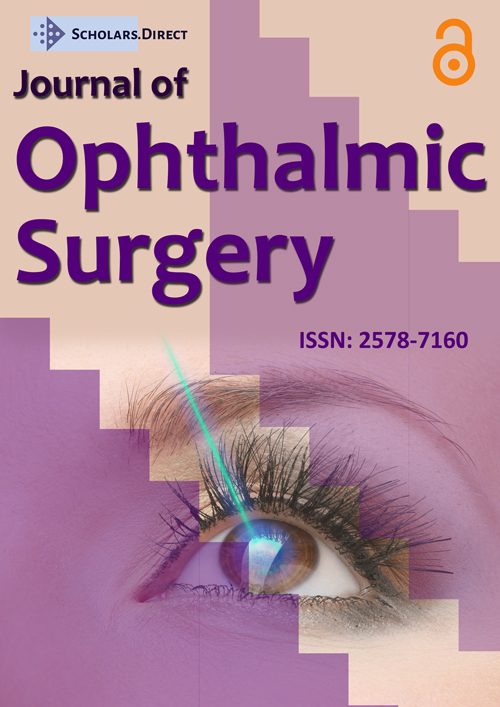Use of Wound Closure Strips to Maximize Ocular Exposure during Cataract Surgery in Patients with Brow Ptosis
Keywords
Cataract surgery, Draping technique, Wound closure strips, Ocular exposure, Brow ptosis
Introduction
Draping is a critical step in successful cataract surgery. Poor exposure of the globe can result in limited access during surgery, thus making the surgeon's task more challenging. Additionally, eyelash exposure from underneath the drape can raise the risk of post-operative endophthalmitis [1]. Maintaining adequate exposure while also retracting the lashes appropriately is particularly challenging in patients with brow ptosis. Here, we present our technique for managing brow ptosis and achieving excellent ocular exposure with the use of wound closure strips.
Technique
The patient's eye, eyelashes, and periocular skin is well-cleansed with 5% povidone-iodine. Sufficient time is allowed for the antiseptic to dry. A surgical drape with an oval cut-out for the operative eye is affixed to the patient's periocular skin (Figure 1 and Figure 2). Steri StripsTM (3M, St. Paul, MN) are placed just below the patient's brow, then used to retract the periocular skin and tissues (Figure 3). A similar technique is used to pull down the inferior periocular skin by placing the strips approximately three millimeters inferior to the lower eyelid margin if needed. This achieves appropriate ocular exposure, even in the setting of brow ptosis and dermatochalasis by retracting the periocular tissues. A piece of transparent film dressing (TegadermTM 3M, St. Paul, MN) of seven centimeters by six centimeters is cut in half its length. The two halves are then used to capture the eyelashes (Figure 4). An eyelid speculum is then inserted, and surgery proceeds as per standards.
Discussion
Our practice has a large number of patients with clinically significant dermatochalasis and brow ptosis. We have found that this technique assists with achieving good ocular exposure and maximizing surgeon access to the globe while maintaining patient comfort. In patients with poor ocular exposure, creating a side port superiorly or inferiorly can be challenging, as there is little space in which to work. Maximizing exposure using this technique facilitates the ease of surgery and allows the surgeon to place the incisions where he or she prefers, without being limited by the periocular tissues. In cases with poor exposure, the assistant may need to manually elevate the brow to achieve access to the globe, but this can be challenging for surgeons operating without an assistant. Our technique decreases the need for an assistant and also may decrease the risk of endophthalmitis by ensuring that the eyelashes are fully covered underneath the surgical field. This technique is useful when performing femtosecond cataract surgery, in which poor ocular exposure can result in the inability to dock the laser suction cup.
Our technique may also help in patients with blepharospasm without the need for a facial block or botulinum toxin injection [2], as this technique holds the periocular tissues in place well. It also facilitates exposure in deep set orbits, thus decreasing the need for a retrobulbar block and subsequent risk for complications [3]. In the past, particularly with the superior approach to cataract surgery, O'Brien's and van Lint's blocks were regularly performed to paralyze the orbicularis muscles and facilitate safe access to the globe. Our draping similarly limits movement of the periocular tissues and muscles with minimal risk, thus maximizing patient and surgeon comfort.
References
- Mamalis N, Kearsley L, Brinton E (2002) Postoperative endophthalmitis. Curr Opin Ophthalmol 13: 14-18.
- Okumus S, Coskun E, Erbagci I, et al. (2012) Botulinum toxin injections for blepharospasm prior to ocular surgeries. Clin Ophthalmol 6: 579-583.
- Martz Teresa G, Justin K, Prum Bruce E Jr., et al. (2018) Cataract surgery and the deep-set eye. JCRS Online Case Reports 6: 62-64.
Corresponding Author
Yasmin Florence Khodeja Islam, MD, Department of Ophthalmology, University of Florida, 6201 West Newberry Road, Gainesville, FL 32608, USA, Tel: 352-265-2020.
Copyright
© 2021 Islam YFK, et al. This is an open-access article distributed under the terms of the Creative Commons Attribution License, which permits unrestricted use, distribution, and reproduction in any medium, provided the original author and source are credited.








